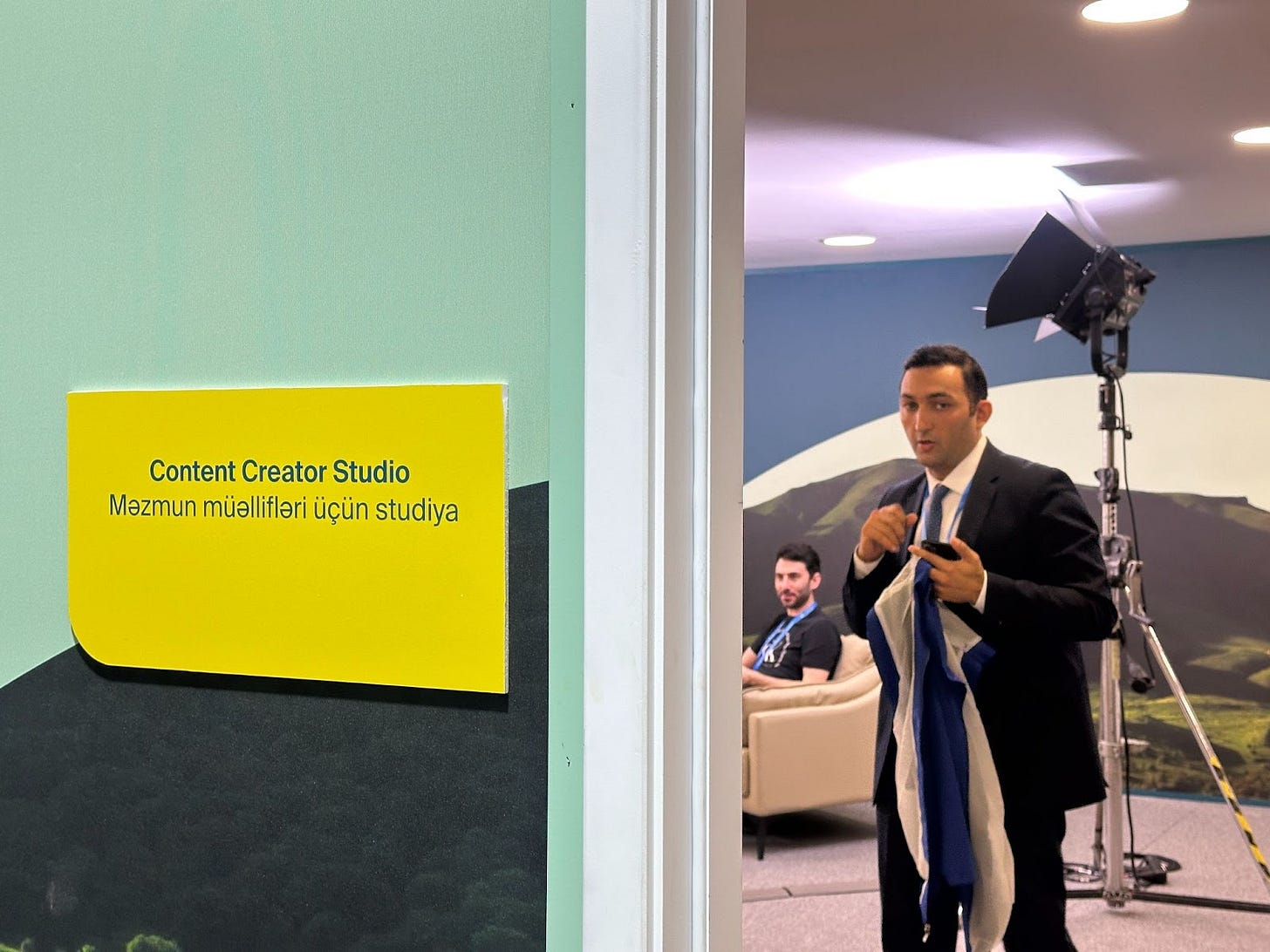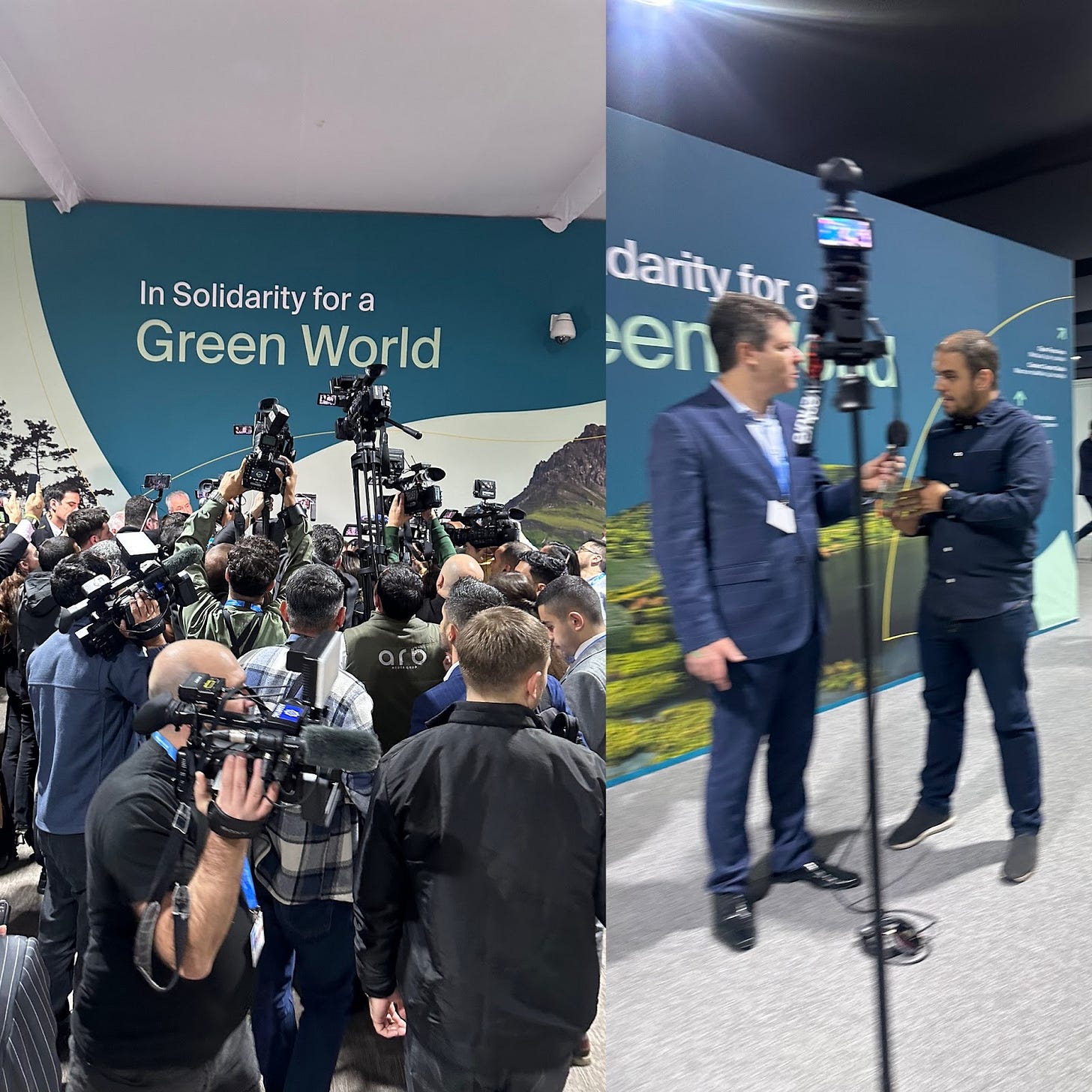Transforming Climate Communications For Video Sapiens: Strategies for Impactful Outreach
In the age of hyper-social media, are communications about crucial issues—like climate change—getting drowned out?
Are we Homo sapiens evolving, in a manner of speaking, into Video sapiens? It’s common to see folks everywhere clutching screens, neck down in content. And the stats show this is a global phenomenon:
Just over a third of the world’s population access YouTube every month.
Globally, people average 6 hours and 40 minutes of screen time daily.
Around 54.3% of YouTube users are between 18 and 34 years old.
News and Content
In the corner of the vast media tent at COP29 in Baku stood a room labelled Content Creator Studio. Its presence blurred the divide between news and content.
To several news puritans, ‘content’ is unseemly. However, the blurring of these lines is inevitable given how rapidly news consumption continues to change. Much of this is now via video on social media consumed on mobile devices. Compounding this, trust and interest in the news are declining.

How Social Media and Video Content Can Transform Climate Messaging
What will it take to stand out in a crowded media landscape? It may broadly be seen as legacy Press and communications are competing for eyeballs against the burgeoning content creator economy.
This discussion focuses on climate change communications because global warming is an existential crisis, with the planet warming faster than ever. The goal, as a new paper on climate messaging highlights, is “Increasing public support for climate action… a significant step toward addressing climate change.”
The news media presents a challenge. Climate change is not a high priority for many mainstream news organizations whose headlines are dominated by politics, business, sports and celebrity news.
A recent survey shows a gap between climate reporting and the ‘information needs’ of audiences. According to the Reuters Institute study, 72% and 64% of those surveyed say their information needs on sports and politics were met, compared to 58% for climate change and environmental news.
But the challenge isn’t limited to the Press. Communications from climate organizations often exist in an echo chamber, circulating within the same audience — liked, shared, and reposted by those already actively engaged in climate conversations. (I use the term "climate organizations" loosely to describe anything from science-focused institutions to sustainability-oriented businesses.)
Simplifying Climate Comms
Global warming may be a critical issue, but climate content faces stiff competition in the media. It’s not typically entertaining or binge-worthy, and getting the message right can be tough.
However, this doesn’t have to be overly complicated. The source material—science and its human and economic impact—is strong. The challenge is converting this into engaging climate content that resonates beyond echo chambers.
The most likely way to achieve this is to use newsroom chops, content creation magic and research and data.
[In this earlier piece, I wrote about ways to achieve this.]
From Air Pollution to Global Warming: Making Climate Stories Resonate
Landing messages about climate change, air pollution, sustainability and related issues can be hard, especially for policy action and behavioural change.
At a recent convening in Bengaluru on India’s air quality crisis, a telling anecdote emerged. A moderator asked attendees — scientists and advocates— to raise their hands if at least five close friends or family members were sufficiently knowledgeable or cared about air pollution. Out of an audience of 50-60 attendees focused on air quality, barely a few hands went up.
This underscores a wider challenge: even those deeply involved in climate advocacy often struggle to bridge the gap between scientific knowledge and broader public awareness.
The Role of Climate Influencers
The communication gap between empirical knowledge and public awareness often lies between long-form news stories (newspaper articles, TV discussions, research papers, etc.) and bite-sized content. This is where climate influencers and short-form video content can thrive.
Making videos can look easy but it is usually hard work. Converting long-form pieces into short, engaging content is possible. The payoff includes greater engagement, potential shifts in awareness and perhaps even an improved profile for the organization. But it isn’t easy. It demands aligned leadership, training and patience, especially in large organizations.
Editorial control and newsroom fundamentals—like attribution, verification, and context—remain vital whether crafting news or content. The challenge lies in distilling pages of information into a single, impactful headline. This effort can be enhanced by one of the most valued traits of content creators: authenticity.
Rise of the Video Sapiens: YouTube Climate Content
At COP29, traditional TV crews with large, cumbersome equipment stood in stark contrast to one-person video teams using cameras, some smaller than a smartphone, likely for digital video platforms.
YouTube serves as a yardstick for video’s dominance. Last year, one billion hours of video were watched on the platform daily. The average viewing time rose to 19 minutes per person in 2022, up from 13 minutes in 2019. Globally, more than half of YouTube’s users are under 35. India leads with 492 million users, surpassing the US and Brazil combined. Viewership analysis shows that people spend over 40% of their waking hours on an internet-connected screen. Not surprisingly even stolid newspapers have started video services.
“Younger groups are more interested in the environment and climate change”- Digital News Report 2024, Reuters Institute, Oxford.
Video is now the dominant media format. Creating it doesn’t require heavy technology. Instead, success depends on original, quality content. That’s exactly where climate communications has immense potential to excel.





